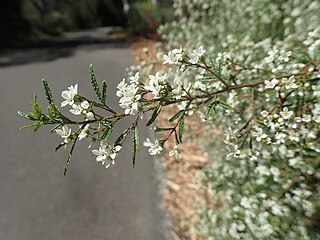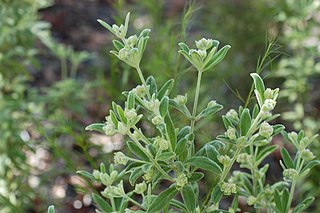Zieria lasiocaulis, commonly known as Willi Willi zieria, is a rare species of flowering plant in the citrus family Rutaceae and is endemic to New South Wales. It is a tall shrub or small tree with three-part leaves and inconspicuous white flowers, found only at high altitudes in areas with a high rainfall.

Zieria aspalathoides, commonly known as the whorled zieria, heath zieria, hairy zieria or heathy zieria, is a plant in the citrus family Rutaceae and is endemic to eastern Australia. It is a heath-like shrub with leaves that appear to be whorled and with pink flowers in groups of three, each with four petals and four stamens.

Zieria laevigata commonly known as smooth zieria, smooth-leaved zieria or twiggy midge bush is a species of flowering plant in the citrus family Rutaceae and is endemic to eastern Australia. It is an erect shrub with smooth, three-part leaves and pale pink or white flowers with four petals and four stamens. It grows in poor soil on rocky outcrops and flowers from late winter to spring.

Zieria arborescens, commonly known as the tree zieria or stinkwood, is a plant in the citrus family Rutaceae and is endemic to eastern Australia. It is a bushy shrub or small tree with branches that are ridged and scaly or hairy, at least when young. It has leaves composed of three leaflets and groups of flowers with four white petals, the groups usually shorter than the leaves.

Zieria adenodonta, commonly known as the Wollumbin zieria, is a plant in the citrus family Rutaceae and is endemic to eastern Australia. It is a dense, bushy shrub with leaves composed of three leaflets which are warty on the upper surface. In winter and early spring it has groups of five to eight flowers, each with four white petals, the groups usually shorter than the leaves.

Zieria tuberculata, commonly known as warty zieria, is a plant in the citrus family Rutaceae and is endemic to a small area on the south coast of New South Wales. It is a shrub with warty, hairy branches and leaves and large groups of creamy-white, four-petalled flowers in late winter to spring.

Zieria buxijugum, commonly known as the Box Range zieria, is a plant in the citrus family Rutaceae and is endemic to a small area on the south coast of New South Wales. It is a dense, rounded shrub with strongly scented, velvety, clover-like leaves composed of three leaflets. In early spring there are large clusters of small white flowers with four petals near the ends of the branches.

Zieria caducibracteata is a plant in the citrus family Rutaceae and is endemic to New South Wales. It is a tall shrub or small tree with leaves composed of three lance-shaped leaflets. In early spring there are clusters of small white flowers with four petals near the ends of the branches.

Zieria covenyi, commonly known as the Coveny's zieria, is a plant in the citrus family Rutaceae and is endemic to a small area in the Blue Mountains of New South Wales. It is an erect shrub which multiples asexually from root suckers and has three-part, clover-like leaves and clusters of white to pink flowers with four petals and four stamens.

Zieria formosa, commonly known as the shapely zieria, is a plant in the citrus family Rutaceae and is endemic to a small area on the south coast of New South Wales. It is a dense, rounded shrub with velvety, clover-like leaves composed of three leaflets. In spring there are clusters of small, pale pink flowers with four petals near the ends of the branches. It is similar to the Box Range zieria which has a similar distribution, but has wider leaflets and an appendage on its anthers.
Zieria hindii, commonly known as the Hind's zieria, is a plant in the citrus family Rutaceae and is endemic to a small area in north-eastern New South Wales. It is an erect, slender shrub with warty branches, three-part, clover-like leaves, and clusters of small white flowers with four petals and four stamens. It is only known from the Nightcap Range.

Zieria ingramii, commonly known as Keith's zieria, is a plant in the citrus family Rutaceae and is endemic to a small area in central New South Wales. It is a slender, spindly, aromatic shrub with three-part, clover-like leaves and clusters of about seven white to pale pink flowers with four petals and four stamens. The species is only known from two state forests near Dubbo.

Zieria involucrata is a plant in the citrus family Rutaceae and is endemic to New South Wales. It is a sparse, erect shrub with mostly three-part leaves and groups of up to 21 small white flowers, the groups shorter than the leaves. It mostly occurs in the lower Blue Mountains, but is also known from other areas around Sydney.

Zieria littoralis, commonly known as dwarf zieria is a plant in the citrus family Rutaceae and is endemic to south-eastern Australia. It is an erect or spreading shrub with velvety, three-part, clover-like leaves and clusters of up to thirty white or pale pink flowers with four petals and four stamens. It grows on exposed, rocky coastal headlands.

Zieria obcordata, commonly known as obcordate-leafed zieria, is a plant in the citrus family Rutaceae and endemic to New South Wales. It is an aromatic, densely branched, rounded shrub with small, hairy, three-part leaves and up to three white to pale pink flowers with four petals and four stamens arranged in the leaf axils. It occurs in two disjunct populations in the central-west of the state.

Zieria odorifera, commonly known as the fragrant zieria, is a plant in the citrus family Rutaceae and is endemic to inland New South Wales. It is an aromatic shrub with ridged branches, leaves composed of three leaflets and groups of mostly three pale to deep pink, four-petalled flowers in spring.

Zieria parrisiae, commonly known as Parris' zieria, is a plant in the citrus family Rutaceae and is endemic to a small area near Pambula on the south coast of New South Wales. It is a bushy shrub with warty, clover-like leaves composed of three leaflets and in spring there are clusters of up to 24 white to pale yellow flowers with four petals, near the ends of the branches.

Zieria pilosa, commonly known as hairy zieria, is a plant in the citrus family Rutaceae and is endemic to coastal New South Wales. It is a shrub with hairy branches, leaves composed of three leaflets and usually only single white to pale pink flowers in the leaf axils.

Zieria southwellii is a plant in the citrus family Rutaceae and is endemic to eastern Australia. It is a large shrub or small tree with its leaves composed of three leaflets, and has groups of large numbers of flowers with four white petals, the groups shorter than the leaves. It grows near rainforest in northern New South Wales and far south-eastern Queensland.
Zieria verrucosa is a plant in the citrus family Rutaceae and is endemic to a small area of Queensland. It is a densely-branched, hairy shrub with three-part, clover-like leaves and large groups of creamy-white to pink, four-petalled flowers.


















